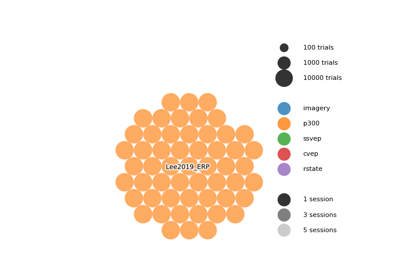moabb.datasets.Wang2016#
- class moabb.datasets.Wang2016[source]#
SSVEP Wang 2016 dataset.
PapersWithCode leaderboard: https://paperswithcode.com/dataset/wang2016-moabb
Dataset summary
#Subj
34
#Chan
64
#Classes
40
#Trials / class
6
Trials length
5 s
Freq
250 Hz
#Sessions
1
Dataset from [1].
This dataset gathered SSVEP-BCI recordings of 35 healthy subjects (17 females, aged 17-34 years, mean age: 22 years) focusing on 40 characters flickering at different frequencies (8-15.8 Hz with an interval of 0.2 Hz). For each subject, the experiment consisted of 6 blocks. Each block contained 40 trials corresponding to all 40 characters indicated in a random order. Each trial started with a visual cue (a red square) indicating a target stimulus. The cue appeared for 0.5 s on the screen. Subjects were asked to shift their gaze to the target as soon as possible within the cue duration. Following the cue offset, all stimuli started to flicker on the screen concurrently and lasted 5 s. After stimulus offset, the screen was blank for 0.5 s before the next trial began, which allowed the subjects to have short breaks between consecutive trials. Each trial lasted a total of 6 s. To facilitate visual fixation, a red triangle appeared below the flickering target during the stimulation period. In each block, subjects were asked to avoid eye blinks during the stimulation period. To avoid visual fatigue, there was a rest for several minutes between two consecutive blocks.
EEG data were acquired using a Synamps2 system (Neuroscan, Inc.) with a sampling rate of 1000 Hz. The amplifier frequency passband ranged from 0.15 Hz to 200 Hz. Sixty-four channels covered the whole scalp of the subject and were aligned according to the international 10-20 system. The ground was placed on midway between Fz and FPz. The reference was located on the vertex. Electrode impedances were kept below 10 KΩ. To remove the common power-line noise, a notch filter at 50 Hz was applied in data recording. Event triggers generated by the computer to the amplifier and recorded on an event channel synchronized to the EEG data.
The continuous EEG data was segmented into 6 s epochs (500 ms pre-stimulus, 5.5 s post-stimulus onset). The epochs were subsequently downsampled to 250 Hz. Thus each trial consisted of 1500 time points. Finally, these data were stored as double-precision floating-point values in MATLAB and were named as subject indices (i.e., S01.mat, …, S35.mat). For each file, the data loaded in MATLAB generate a 4-D matrix named ‘data’ with dimensions of [64, 1500, 40, 6]. The four dimensions indicate ‘Electrode index’, ‘Time points’, ‘Target index’, and ‘Block index’. The electrode positions were saved in a ‘64-channels.loc’ file. Six trials were available for each SSVEP frequency. Frequency and phase values for the 40 target indices were saved in a ‘Freq_Phase.mat’ file.
Information for all subjects was listed in a ‘Sub_info.txt’ file. For each subject, there are five factors including ‘Subject Index’, ‘Gender’, ‘Age’, ‘Handedness’, and ‘Group’. Subjects were divided into an ‘experienced’ group (eight subjects, S01-S08) and a ‘naive’ group (27 subjects, S09-S35) according to their experience in SSVEP-based BCIs.
Warning
The original dataset includes two channels labeled ‘CB1’ and ‘CB2’, which are not part of the standard 10-20 EEG montage. Although the authors of Wang2016 state that the 10-20 layout was used, the provided channel location file suggests that ‘CB1’ and ‘CB2’ may correspond approximately to ‘P9’ and ‘P10’. However, this mapping is not confirmed, and the exact locations remain uncertain.
In this implementation, we treat ‘CB1’ and ‘CB2’ as standard EEG channels, following the approach used by the authors.
Users should be aware of this ambiguity when interpreting spatial analyses or when comparing to other datasets with strictly standard montages.
References
[1]Y. Wang, X. Chen, X. Gao and S. Gao, 2017, “A Benchmark Dataset for SSVEP-Based Brain–Computer Interfaces,” in IEEE Transactions on Neural Systems and Rehabilitation Engineering, vol. 25, no. 10, pp. 1746-1752, doi: 10.1109/TNSRE.2016.2627556.
- data_path(subject, path=None, force_update=False, update_path=None, verbose=None)[source]#
Get path to local copy of a subject data.
- Parameters:
subject (int) – Number of subject to use
path (None | str) – Location of where to look for the data storing location. If None, the environment variable or config parameter
MNE_DATASETS_(dataset)_PATHis used. If it doesn’t exist, the “~/mne_data” directory is used. If the dataset is not found under the given path, the data will be automatically downloaded to the specified folder.force_update (bool) – Force update of the dataset even if a local copy exists.
update_path (bool | None Deprecated) – If True, set the MNE_DATASETS_(dataset)_PATH in mne-python config to the given path. If None, the user is prompted.
verbose (bool, str, int, or None) – If not None, override default verbose level (see
mne.verbose()).
- Returns:
path – Local path to the given data file. This path is contained inside a list of length one, for compatibility.
- Return type:
